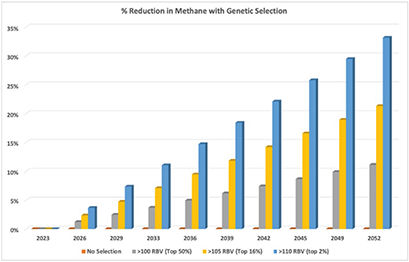
By 2050
Herds Can Reduce Emissions
20-30% by 2050

Methane Efficiency
Independent From Other Traits

Permanent And Cumulative

Elevate®
Index Available On All Holstein Tested Females

Reliable

Herds Can Reduce Emissions
20-30% by 2050

Independent From Other Traits


Index Available On All Holstein Tested Females

Methane (CH4) is a colorless, odorless gas composed of carbon and hydrogen that enters the atmosphere from both human related activities and natural sources. It is also a potent greenhouse gas contributing to climate change.
Semex, our customers and all of production agriculture are under the same climate scrutiny as all companies or organizations. As the global dairy cow is a significant source of methane emissions, Semex and every dairy producer in the world should be very interested in reducing methane.
Multiple studies show that the cow plays a driving role when it comes to methane production. In 2020, Zhang et al. discovered that host genetics and rumen microbiome jointly explained 31% of methane emission variation. Twenty-four percent of the variance was explained by host (cow) genetics, while the balance (7%) was explained by the rumen microbiome (rumen microbes). They also suggested that the host’s genetics impact ruminal methane emissions via mechanisms other than composition of the rumen microbiome.
Canada has been recording milk Mid-Infrared (MIR) data from individual samples since 2013. The Canadian dataset includes more than 13M records from 1.6M cows. MIR spectroscopy relies on light absorption. The analysis produces a spectrum that passes infrared radiation through a sample, and measures the absorptions made by each type of milk compound bond. This can be used to predict different traits from milk samples including components, SCS and more recently methane production.
The official evaluation will be expressed as “Methane Efficiency”, i.e., production of methane at the same level of milk, fat and protein yield. In this way, the evaluation is independent of production and will not penalize productive, efficient animals. This importantly ensures the world will not need more cows to produce enough food, negating any individual cow methane reductions.
Methane efficiency is designed to be genetically independent from milk, fat and protein yield. The genetic correlations between methane efficiency and other economically important traits is low. Functional traits (i.e., daughter fertility, metabolic disease resistance) have low but favorable correlations with methane efficiency.
Initially the evaluation will only be available for Holsteins. As Canada expands the reference population to other breeds, prediction equations will become available.
Producers that have already genomically tested with Elevate® or test before the April genetic evaluation, will automatically receive methane emission genomics. This allows them to benchmark and monitor their methane emissions for every animal tested with Elevate.
Methane’s global warming potential is an estimated 25–35 times greater than carbon dioxide (CO2) over a 100-year period, making methane emissions a climate change concern. Forty percent of global methane emissions are from agriculture. Dairy cows, as ruminants, produce methane from gut fermentation.
Approximately 90% of methane from cows is excreted by eructation (burping) rumen gases from their mouths. This is a rumen fermentation byproduct and is often referred to as enteric methane emissions.
Measuring methane is expensive and difficult. Collecting methane emission data in research herds was made possible through two large-scale international projects led by Canadian researchers receiving funding from Genome Canada, and provincial genome centres and ministries. Methane emission was measured on +500 individual cows using the GreenFeed System.
Yes! The genetic correlation between MIR predicted methane and methane measured with the GreenFeed System is 0.85, demonstrating that the genomic value methane predictions using MIR data is a very efficient and cost-effective way to select for methane reduction.

Dairy producers can expect to achieve 20-30% reduction in methane emissions from their herd by 2050 depending on their selection pressure.
The genetic correlation between Feed Efficiency and Methane Efficiency breeding values is low, confirming that these are genetically different traits. Ideally, milk producers would benefit by selecting for both traits.
No. This evaluation only targets enteric methane. The methane produced from the manure is the result of anaerobic processes happening after excretion.